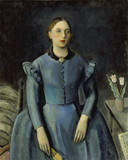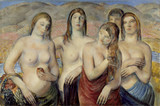Most often associated with Woodstock, New York, and Detroit, John Carroll is best known for his paintings of mysterious, sad-eyed women. He grew up in San Francisco, where he attended the Mark Hopkins Art Academy from 1902 to 1906; he studied at the University of California, Berkeley, in the early 1910s. He also studied briefly with Frank Duveneck (1848-1919) in Cincinnati before serving in the navy during World War I. After the war he lived in New York City and beginning about 1920 also in Woodstock, where he associated with both modernist and Ash Can school artists. Although he produced some portraits, during this period he devoted himself to painting landscapes and figure studies, incorporating the modernist ideas of Paul Cézanne (1839-1906), GEORGE BELLOWS, and ANDREW DASBURG. During the 1920s Carroll became known as one of the most promising modernist artists, and solo exhibitions of his work were held at the Daniel and the Rehn galleries.
Carroll traveled to Europe in 1924 and again in 1927, the second time as a Guggenheim Fellow. He taught at the Art Students League in New York in the late 1920s, and in 1930 he was appointed head of the art department of the Arts and Crafts Society in Detroit. He taught there for more than a decade, during which time he painted frescoes for the Detroit Institute of Arts. His easel paintings underwent a transformation and lost their modernity as he became obsessed with images of mysterious, wide-eyed, sad females. During the early 1940s Carroll briefly abandoned art to settle in East Chatham, New York, to raise cattle for the war effort. Within a short time, however, he returned to painting and teaching, resuming his position in New York at the Art Students League in 1944 and opening his own school in 1951. His late art exemplified a new style, more opaque and vigorous than his earlier, softly romantic paintings.
BIBLIOGRAPHY
Archiv. Am. Art, John Carroll Papers § Augusta Owen Patterson, "The Art Creed of John Carroll," International Studio 83 (February 1926): 75-79 § Harry Salpeter, "John Carroll: Non-Conformist," Esquire 10 (August 1938): 6567, 157-59 § Ernest W. Watson, "John Carroll: Interview," American Artist 15 (January 1951): 28-34 § Obituary, New York Times, November 8, 1959, p. 88.


